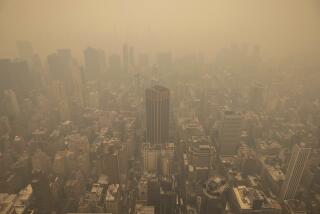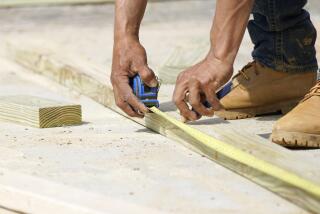Pick healthful indoor building materials and breathe easier
- Share via
Question: My two daughters suffer from allergies and asthma. When we remodel next year, we need to end up with cleaner indoor air. What should we do?
Answer: My first thought is that you should not live there during the remodel. Even with control measures, construction dust will infiltrate your house.
Drywall dust is the worst. One Manhattan Beach homeowner I visited developed long-lasting breathing problems during a massive remodel.
You also should think about minimizing pollutants that will get trapped inside the house, especially during winter, when windows tend to stay closed.
Until fairly recently, indoor air pollutants were considered a limited phenomenon. But two basic changes in construction techniques have altered this. Nowadays, thousands of pest- and rot-ridding chemicals are being incorporated into building materials. Also, as a result of the energy crisis of the 1970s, buildings are now sealed tightly.
The chemicals remain trapped inside, where inhabitants inhale them into their lungs and absorb them into their skin.
It’s common to dream of new windows to dress up an old house, but it’s often after their installation that indoor air problems turn up. Imagine smelling your breakfast bacon late into the afternoon.
That’s a house that needs a filtration system.
To get some guidance on healthful remodeling, I turned to Dennis Allen of Allen Associates in Santa Barbara (www.dennisallenassociates.com), whose firm aggressively pushes for more healthful buildings.
Contractor’s answer: If you want a more healthful house, everyone involved with the remodel -- designer or architect, contractor and engineers -- needs to buy into it. If you cannot find professionals with such a track record, make certain your team members are open to new ideas. If they don’t have healthful-house experience, it will be up to you to research the products that go into your home.
The good news is that you can find building materials without harmful chemicals. Most of these products are still not mainstream, but they are available.
With the proper knowledge, it is no more difficult or expensive to build with good health in mind than it is without. But someone on the team (and it may be you) must pay attention to what’s going into the home, including the furnishings and cleaning products.
There is a material safety data sheet readily available from the manufacturer of every product. It provides information on the harmful ingredients in a product and their effects on health. Someone needs to gather, read and evaluate these sheets for every product you plan on putting into your home.
That may sound daunting. So, at a minimum, eliminate the main culprits.
First, minimize carpeting. Even carpeting that does not emit chemicals will still trap millions of microorganisms as well as pesticides, mold spores, soil particles and animal waste that get tracked inside. People without allergies may be able to live comfortably with what gets trapped in carpeting but not those with allergies.
Avoid manufactured wood products (plywood, laminated cabinet doors, etc.) with glues that release formaldehyde; most of them do. Use no paints, finishes, adhesives or sealants that emit volatile organic compounds, or VOCs. Because of recent public demand, it’s likely that your local paint stores carry non-VOC paints. Just ask.
And finally, steer clear of natural gas water heaters and furnaces that release burned combustion gases into the indoor air. Closed-combustion appliances are OK when their gases are channeled directly outside.
Follow these guidelines, and your air quality can be vastly improved. Still more measures may be required for those with severe sensitivities.
Submit remodeling questions to Kathy Price-Robinson at www.kathyprice.com, or to Editor, Real Estate Section, Los Angeles Times, 202 W. 1st St., Los Angeles, CA 90012.


